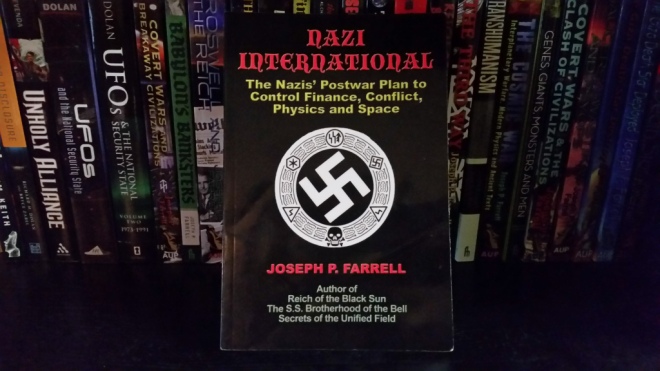
BreakawayConsciousness
Zy Marquiez
April 11, 2016
The Nazi International – The Nazi’s Postwar Plan To Control Finance, Conflict, Physics And Space by Dr. Joseph P. Farrell, is essentially the prequel to his latest endeavour, The Third Way – The Nazi International, The European Union & Corporate Fascism.
Farrell’s book series usually come in trilogies, and although as mentioned this isn’t the prequel, it sure follows suit similar to how his previous trilogies would build on each other.
If you’ve read Farrell’s latest book, The Third Way, then you will want to read this book to be able to further delve into the inner workings of the Nazi mindset, and how they were able to accomplish what they did. And even if you haven’t, this is a great starting place from which to branch out into Farrell’s many other books which talk about the many aspects of the Nazis that most people are unknowledgeable about.
Moving on, Farrell gives a top-down lengthy synopsis into a sizeable breath of the Nazi’s post-WWII war machine.
Farrell begins by noting what he’s mentioned in countless interviews, which is that the military of Germany – the Nazis – did not surrender. That alone is an excellent foundation to the notion that the Nazi’s weren’t ones to roll over and die as many would have you believe. A small, but notable data point, because it extends further into the future. All the way into the present, in fact. In contrast, the Japanese surrendered in WWII was very neatly accomplished.
From there, the author continues with various examinations into the Nazi connection with corporations, spearheaded by the notorious I.G. Farben and its penetration of big banks, to the growth of the Nazi postwar network lead by Bormann. In conjunction with that, Farrell lays down many of the intricacies that allowed the Nazis not only to survive in a post-WW2 environment, but to actually thrive. That is a rather disturbing prospect indeed.
Another notable component that goes oft-overlooked is the analysis of Hitler’s alleged death. Many people take it a face value that he committed ‘suicide’. Farrell notes many of the points that are pointed out in a particular article which helps him sift through and narrow down what the probable truth might have been. That is rather intriguing as it would literally change history in more ways than people could imagine.
The Nazis surviving in a post-WWII establishment is a bold, but truthful claim. But the possibility of the boss – the very Nazi symbol – also making it through? Now that will make some folks’ head spin.
Not only is Hitler addressed, but his second in command, Martin Bormann is also all over this book.
Other quite notable components of the story are the Vatican’s connection to the Nazi ratlines, Argentina’s connection to the Nazis before and after the war, as well as how key individuals like Allen Dulles’ are involved in this whole ordeal.
Farrell from there does a compelling job of addressing what the actual postwar Nazi plans were, many of which serve not only to enrich them, but which helped further their power structure.
Another very incisive, and oft-overlooked component in Farrell’s research is the fact that the Nazis played an integral role in the Muslim world. This arguably has probably continued to this day, which is quite distressing. If such is the case, the whole Muslims-are-terrorist meme needs to be examined with precision, because behind the scenes much of what seems to be one element, might just be another. The surge of terrorism that has ensued since must be questioned given how much it has served to fracture how the US is seen in the world, how much profits the military industrial complex has achieved, and how much control over the region has been established in the Middle East and beyond. That’s not to say people are not responsible for their own actions. However, who drives those actions is just as, if not more important because that would be the root cause, rather than one addressing the symptom by only focusing on Muslims.
In any case, Farrell furthers his research by addressing technological components the Nazis were working on such as the notorious Bell, while also examining NASA’S secret history in connection to his thesis.
This book will make the reader see history from a few different lenses, much different than what conventional historians would have you even consider.
Mainstream history must fit in a box, especially since the lot of it is manufactured by the victors.
Anything that doesn’t fit in the box, anything that questions official records, anything that makes one think deeply about different possibilities helps fracture conventional narratives and bring about a wider scope of transformation. This book serves to do just that.
This book is the microscope from which to view post-WW2 Nazi machinations, and it does it in a way that’s sound, breathtaking and yet intriguing. That alone is worth the price of the book.
But when you couple all of the above to the fact that people with the same Nazi-like mindset are still around [think of the Bushes, and the many corporate connections in America that took place during WW2 for starters] and share the same ideals et al., it makes it vital for individuals to know what’s going on, which makes this book much more important.